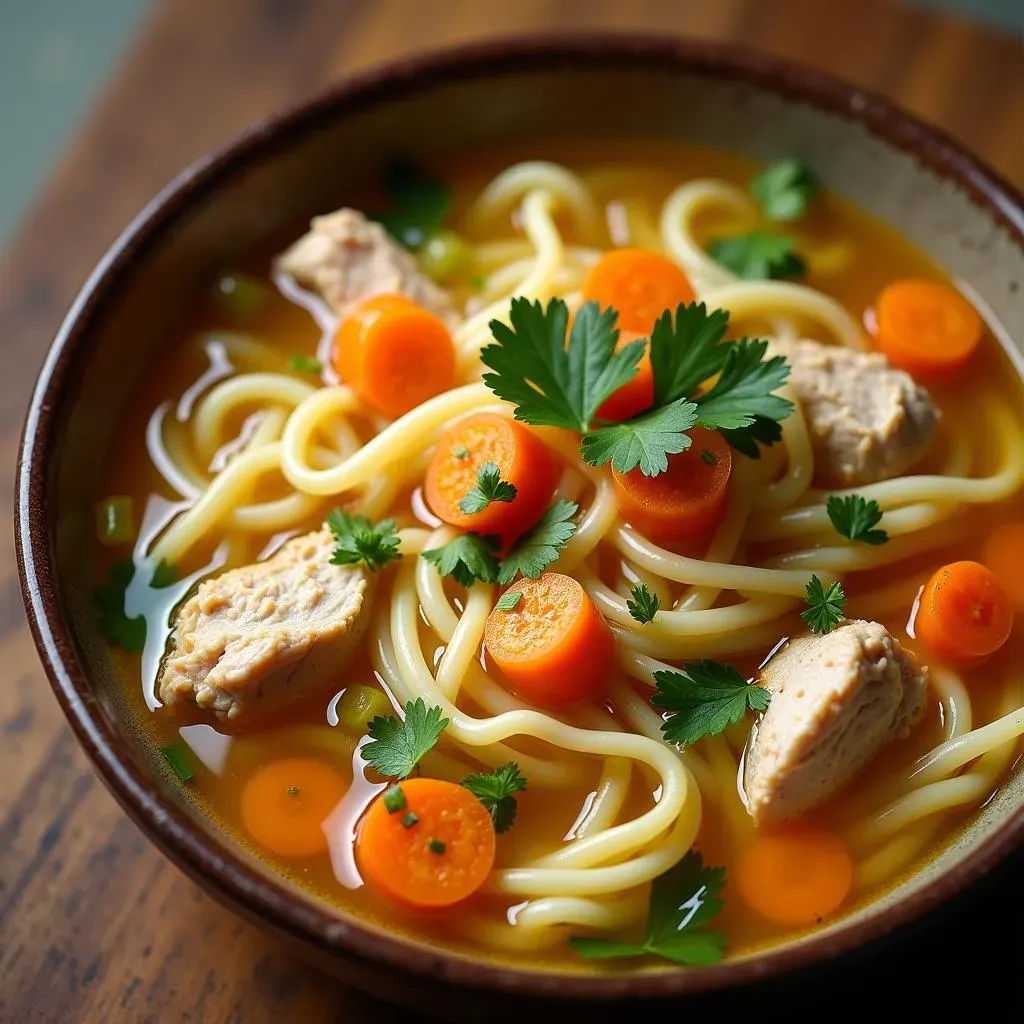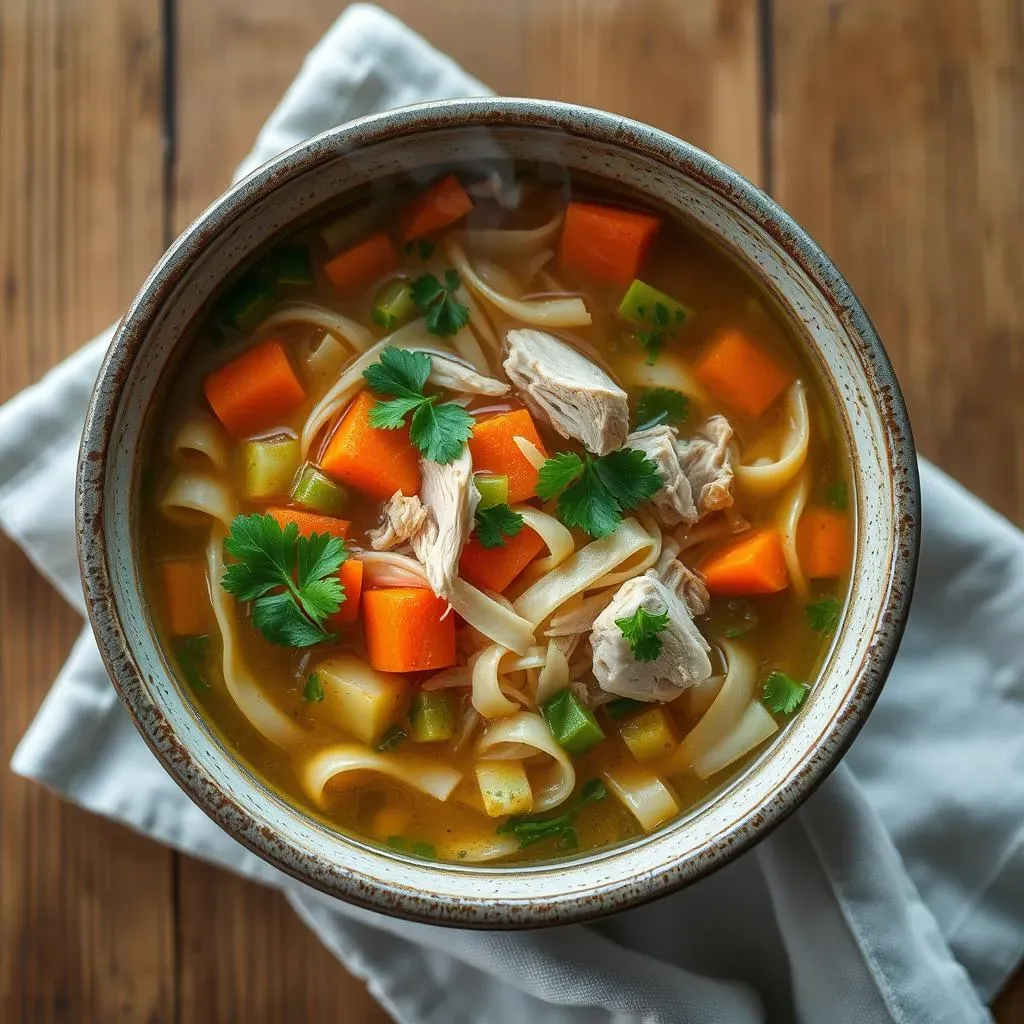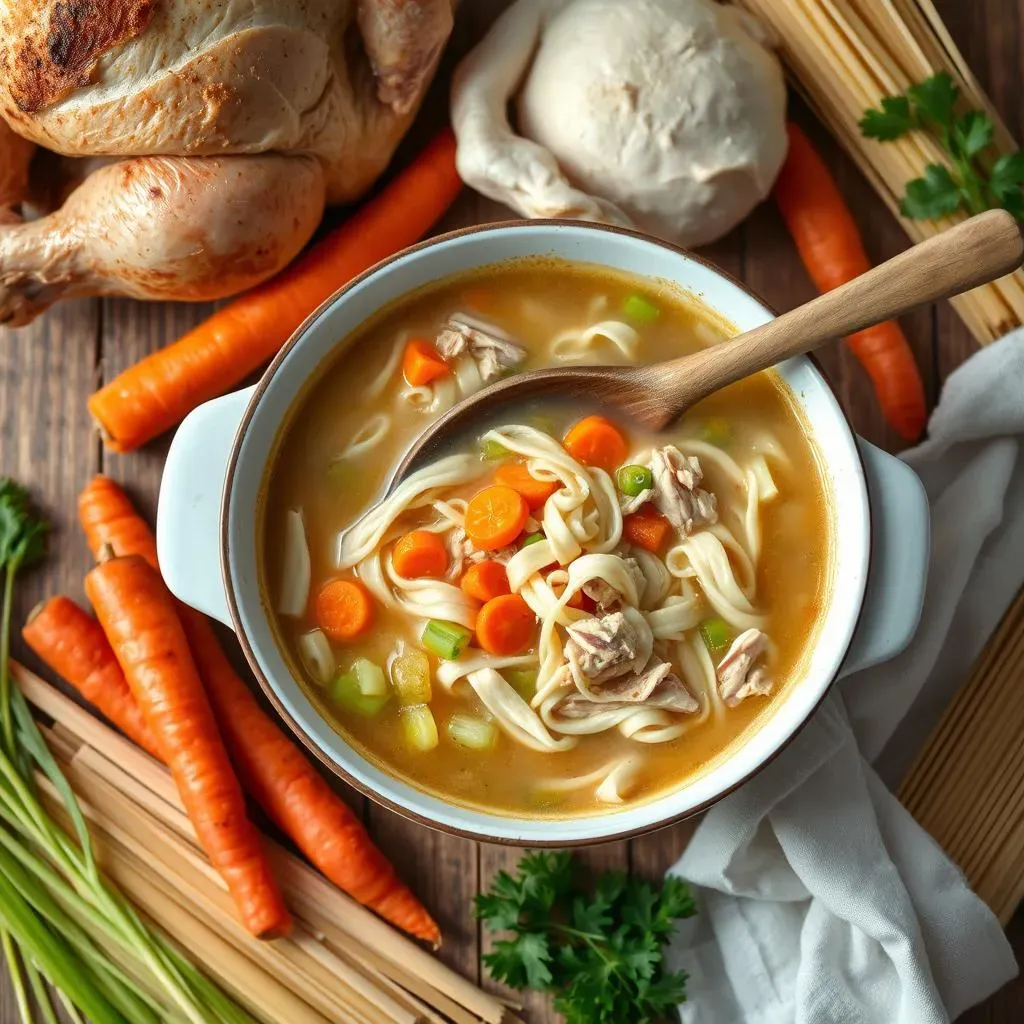Table of Contents
Is there anything more comforting than a bowl of homemade chicken noodle soup? Especially when you're feeling under the weather or just need a warm hug from the inside out? Forget the canned stuff – we're diving headfirst into a fresh chicken noodle soup recipe that'll blow your mind and warm your soul. We're talking about that kind of soup that your grandma used to make, but with a few modern twists to make it even easier and more delicious. Think tender chicken, perfectly cooked noodles, and a broth so rich and flavorful, you'll want to bottle it up. In this article, we're going to walk you through every step of creating the ultimate fresh chicken noodle soup. From choosing the best chicken (rotisserie is our secret weapon!) to making your own egg noodles (it's easier than you think!), we've got you covered. We'll also explore some fun variations and ingredient swaps to customize the recipe to your liking. Plus, we'll break down the nutritional info, so you can enjoy this comforting classic guilt-free. So, grab your apron, and let's get cooking!
The Secret to the Best Fresh Chicken Noodle Soup

The Secret to the Best Fresh Chicken Noodle Soup
Quality Ingredients: The Foundation of Flavor
Let's be real, the secret to any amazing dish starts with the ingredients. For chicken noodle soup, this means skipping the sad, flavorless chicken breasts and opting for something with a little more oomph. A rotisserie chicken is your best friend here! Not only does it save you time, but the meat is incredibly juicy and flavorful, and the carcass is perfect for making a rich, golden broth. Trust me, that store-bought broth just doesn't compare.
Don't skimp on the veggies either. A classic mirepoix – that's carrots, celery, and onion – is essential for building a deep, savory base. Fresh herbs like parsley and thyme add a bright, aromatic touch. And of course, good quality noodles are a must. While you can use dried noodles in a pinch, homemade egg noodles take this soup to a whole new level. We'll show you how later!
Homemade Broth: Liquid Gold
listen up, because this is where the magic really happens. Forget the canned stuff – homemade broth is the heart and soul of incredible chicken noodle soup. It's surprisingly easy to make, and the flavor is unbelievably better. After you've carved up that rotisserie chicken, toss the carcass into a large pot with your mirepoix, some garlic cloves, a bay leaf, and a few sprigs of fresh thyme. Cover it all with water, bring it to a boil, then reduce the heat and let it simmer for at least an hour, or even longer for a deeper flavor.
The longer it simmers, the more flavor you'll extract from the bones and vegetables. Once it's done, strain the broth through a fine-mesh sieve to remove any solids. And there you have it – liquid gold, ready to transform your soup into something truly special.
The Right Noodles: From Store-Bought to Homemade
The noodles are a critical component of chicken noodle soup, and choosing the right ones can make or break the dish. While you can certainly use store-bought egg noodles, making your own is surprisingly simple and elevates the soup to gourmet status. All you need is flour, eggs, and a little salt. Knead the dough, roll it out thinly, and slice it into strips. Let them dry for a bit before adding them to the soup, and they'll cook up perfectly tender and chewy.
If you're short on time, store-bought noodles are perfectly fine. Just be sure to choose a good quality brand and cook them al dente so they don't get mushy in the soup. And for a gluten-free option, try using gluten-free egg noodles or even rice noodles.
Noodle Type | Texture | Flavor | Best for |
|---|---|---|---|
Homemade Egg Noodles | Tender, chewy | Rich, eggy | Ultimate comfort food |
Store-Bought Egg Noodles | Firm, slightly chewy | Mild | Quick & easy |
Gluten-Free Noodles | Varies depending on brand | Varies depending on ingredients | Dietary restrictions |
Making Fresh Chicken Noodle Soup: StepbyStep

Making Fresh Chicken Noodle Soup: StepbyStep
Alright, let's get down to the nitty-gritty of actually making this amazing fresh chicken noodle soup! First things first, if you're going the homemade broth route (and I highly recommend it!), get that simmering away. While the broth is doing its thing, you can prep your veggies. Dice your carrots, celery, and onion into small, uniform pieces. This ensures they cook evenly and adds to the overall presentation of the soup. Mince a couple of cloves of garlic and chop some fresh parsley and thyme. If you're making homemade noodles, now's the time to get that dough going. It only takes a few minutes, and the results are so worth it!
Once the broth is ready, strain it into a clean pot. Add your diced veggies and garlic and bring to a simmer. Cook until the vegetables are tender, about 10-15 minutes. Now, shred the meat from your rotisserie chicken and add it to the pot. If you're using store-bought noodles, add them now and cook according to package directions. If you're using homemade noodles, add them a few minutes before the vegetables are done, as they cook quickly. Finally, stir in your fresh parsley and thyme. Season with salt and pepper to taste, and you're ready to serve!
Step | Action | Why? |
|---|---|---|
1 | Simmer broth | Deepens flavor |
2 | Prep veggies | Even cooking |
3 | Add veggies & garlic | Builds savory base |
4 | Add chicken | Protein power! |
5 | Add noodles | Comfort factor |
6 | Add herbs & seasoning | Freshness & flavor boost |
Ingredient Swaps & Variations for Your Chicken Noodle Soup Recipe

Ingredient Swaps & Variations for Your Chicken Noodle Soup Recipe
Veggie Power-Ups
Want to sneak in some extra nutrients? Chicken noodle soup is incredibly versatile when it comes to vegetables. Feel free to add in whatever you have on hand or whatever your family enjoys. Zucchini, spinach, kale, peas, green beans, corn – the possibilities are endless! Just toss them in during the last few minutes of cooking, so they retain their vibrant color and don't get mushy. For a heartier soup, try adding diced potatoes or sweet potatoes. They'll add a lovely sweetness and creaminess to the broth.
If you're feeling adventurous, consider adding some mushrooms. Shiitake, cremini, or even button mushrooms would all work well. Sauté them with the mirepoix to bring out their earthy flavor before adding them to the soup. Roasting vegetables before adding them to the soup can also add another layer of flavor.
Noodle Nirvana
While egg noodles are the classic choice for chicken noodle soup, don't be afraid to experiment with other types of noodles. Wide egg noodles, thin spaghetti, ditalini, or even orzo pasta would all be delicious. For a healthier option, try whole wheat pasta or zucchini noodles (zoodles). Just be mindful of the cooking time, as different types of noodles will cook at different rates. If you're using gluten-free noodles, be sure to choose a brand that holds its shape well and doesn't get mushy.
Also, you can try adding dumplings instead of noodles. These can be simple drop dumplings made from flour, baking powder, and milk, or more elaborate dumplings filled with herbs and cheese. Either way, they'll add a delightful pillowy texture to the soup.
Noodle Substitute | Flavor Impact | Texture | Considerations |
|---|---|---|---|
Zucchini Noodles (Zoodles) | Mild, slightly sweet | Soft, tender | Add at the very end, don't overcook |
Orzo Pasta | Neutral | Small, rice-like | Cooks quickly, watch carefully |
Whole Wheat Pasta | Nutty | Chewier than white pasta | May require longer cooking time |
Broth Boosters & Protein Power-Ups
Want to take your broth to the next level? Try adding a splash of lemon juice or apple cider vinegar at the end for a bright, tangy flavor. A dash of hot sauce or a pinch of red pepper flakes can add a subtle kick. And for an extra layer of umami, try adding a tablespoon of soy sauce or fish sauce.
If you're not a fan of chicken, or you simply want to add more protein, try using turkey, ham, or even chickpeas. For a vegetarian option, skip the chicken altogether and use vegetable broth. Add some tofu or tempeh for a protein boost. And don't forget the garnishes! A sprinkle of fresh dill, chives, or a dollop of sour cream or Greek yogurt can add a finishing touch of flavor and creaminess.
Fresh Chicken Noodle Soup Recipe: Nutrition & Macro Breakdown

Fresh Chicken Noodle Soup Recipe: Nutrition & Macro Breakdown
Understanding the Nutritional Profile
so you've got this amazing bowl of fresh chicken noodle soup, but what exactly are you putting into your body? Let's break it down. Chicken noodle soup is generally a good source of protein, thanks to the chicken, and provides some vitamins and minerals from the vegetables. The broth, especially if homemade, can be rich in collagen, which is great for your skin and joints. However, the nutritional content can vary widely depending on the ingredients you use. For example, using whole wheat noodles will increase the fiber content, while adding extra vegetables will boost the vitamin and mineral count.
Pay attention to the sodium content, especially if you're using store-bought broth or canned ingredients. Too much sodium can negate some of the health benefits of the soup. Making your own broth and controlling the amount of salt you add is always the best option.
Macro Breakdown & Calorie Count
Now, let's talk macros. A typical serving of fresh chicken noodle soup (about 1.5 cups) will generally contain a good balance of carbohydrates, protein, and fat. The exact numbers will depend on your specific recipe, but here's a general estimate:
- Calories: 200-300
- Protein: 15-25 grams
- Carbohydrates: 20-30 grams
- Fat: 5-10 grams
These numbers can fluctuate based on the amount of chicken, noodles, and vegetables you use, as well as the type of fat you use for sautéing the vegetables. Keep in mind that these are just estimates, and it's always best to calculate the macros based on your specific recipe for the most accurate information.
Tips for a Macro-Friendly Soup
Want to make your fresh chicken noodle soup even healthier? Here are a few simple tweaks you can make. First, opt for lean chicken breast instead of dark meat to reduce the fat content. Second, use whole wheat noodles or zucchini noodles to increase the fiber and lower the carb count. Third, load up on the vegetables! The more veggies you add, the more nutrients you'll get without significantly increasing the calorie count. Fourth, use low-sodium broth or make your own to control the sodium levels.
Finally, be mindful of portion sizes. It's easy to overeat soup, especially when it's as delicious as this! Stick to a reasonable serving size to keep your calorie intake in check. By making these simple adjustments, you can enjoy a comforting and nutritious bowl of fresh chicken noodle soup without derailing your diet.
Macro | How to Adjust | Impact |
|---|---|---|
Protein | Use lean chicken breast, add chickpeas | Increases protein, reduces fat |
Carbohydrates | Use whole wheat noodles, add more veggies | Increases fiber, lowers glycemic index |
Fat | Use lean chicken, skip sautéing in oil | Reduces overall fat content |
Sodium | Use low-sodium broth, limit salt | Reduces sodium intake |
Reader Reviews & Tips for the Perfect Chicken Noodle Soup

Reader Reviews & Tips for the Perfect Chicken Noodle Soup
What Readers Are Saying
so I've been making this fresh chicken noodle soup recipe for my family for years, and let me tell you, it's a crowd-pleaser! But don't just take my word for it. I've scoured the comments section and rounded up some of the best reviews and tips from fellow soup enthusiasts. One reader, Sarah, raves about how easy it is to make, even on a busy weeknight. She says, "I used a rotisserie chicken and pre-cut veggies to save even more time. My kids devoured it!" Another reader, Mark, suggests adding a squeeze of lemon juice at the end for a bright, tangy flavor. He says it really elevates the soup and makes it taste even fresher.
But it's not just about the taste – many readers appreciate how customizable this recipe is. Lisa mentions that she always adds extra garlic and ginger for an immune-boosting kick, especially during cold and flu season. And David shares that he uses gluten-free noodles and bone broth to make it allergy-friendly for his family. It's awesome to see how people are adapting this recipe to fit their individual needs and preferences!
Pro Tips for Soup Success
Alright, now for the inside scoop! Based on my own experience and the wisdom of my readers, here are some pro tips to help you make the perfect fresh chicken noodle soup every time. First, don't be afraid to experiment with different herbs and spices. A bay leaf, some fresh thyme, or even a pinch of red pepper flakes can add depth and complexity to the flavor. Second, be careful not to overcook the noodles. Nobody likes mushy noodles! Add them towards the end of cooking and cook until they're just al dente.
Third, if you're making homemade broth, don't skimp on the simmering time. The longer you simmer the broth, the richer and more flavorful it will be. And finally, don't forget to season your soup properly. Taste it frequently and adjust the salt and pepper as needed. A little bit of seasoning can go a long way in bringing out the flavors of the soup. With these tips in mind, you're well on your way to making a truly unforgettable bowl of fresh chicken noodle soup!
Tip | Details | Benefit |
|---|---|---|
Experiment with herbs | Bay leaf, thyme, red pepper flakes | Adds depth and complexity |
Don't overcook noodles | Add near the end, cook al dente | Prevents mushy noodles |
Simmer broth longer | Minimum 1 hour, longer for richer flavor | Enhances broth flavor |
Season properly | Taste frequently, adjust salt/pepper | Brings out the flavors |
Slurping Our Way to Happiness: The Fresh Chicken Noodle Soup Finale
So there you have it – your ticket to homemade chicken noodle soup nirvana! This fresh chicken noodle soup recipe isn't just about following steps; it's about creating an experience, a memory, a bowl of pure comfort. Whether you stick to the classic version or get adventurous with ingredient swaps, the most important thing is to enjoy the process and savor every spoonful. Now, go forth and conquer that craving! And don't forget to share your creations and variations – we can't wait to see what you come up with.
